The size of the smart TV market in 2023 was a whopping $208 billion. According to analysts, this figure will show a steady growing trend and reach an impressive $711 billion by 2032, which corresponds to an average annual growth of 14.3%. This is due to the functionality and advantages over conventional TV.
Over the past five years, LG has been one of the leaders in the global smart TV market, ranking second with an 18.5% share. Together with Samsung, LG controls almost half of the Over-the-Top TV (OTT TV) production, providing millions of users with high-quality video content.
LG Smart TV is based on webOS. This is not simply an operating system, but a real revolution in the Smart TV industry. An intuitive interface, voice screen navigation, and personalized recommendations make webOS development solutions an interesting area for business investment.
In this article, we will consider the features of webOS app development and the benefits of it from the business point of view.
WebOS: More Than Just a TV Operating System
Initially created by Palm as a mobile operating system based on the open-source operating system Linux, webOS was acquired by LG in 2013 and became one of the most popular smart TV platforms on the market.
It adheres to the general streaming protocol HLS, but it also has limited compatibility with VOD streams.
To ensure high quality TV programs, the operating system sets minimum requirements for graphics resolution: 1280 x 720 (2K) for Full HD and 1920 x 1080 (2K) for Ultra HD. For video playback, webOS requires optimizing the screen resolution to 1920 x 1080 (2K) for Full HD and 3840 x 2160 (4K) for Ultra HD, depending on the model.
As a leading player in TV technology, LG is constantly introducing new Smart TV models while improving hardware and software to enhance performance. The improved webOS 6 has 1.3 GB of storage.
WebOS is a great example of a system with a lot of room for expansion. It is suitable not only for smart TVs but also for digital signage, smart home appliances, wearables, robots, and cars.
LG webOS app development by Lampa will add value to your product through the integration of LG AI ThinQ. This technology provides access to advanced features of an AI-enabled smart TV, such as automatic sound and image quality adjustment, on-screen voice navigation, and sports event notifications. You can also use your LG TV as a control panel for other smart home appliances and stream content to your mobile devices.
Essential WebOS Functions
To better understand the inner workings of webOS, it is worth familiarizing yourself with its main technical characteristics and application development features. During webOS apps development, specialists create applications using JavaScript, TypeScript, HTML5, and CSS3. TV WebAPI, Luna Service API, and webOSTV.js are APIs that provide the necessary services and functions for future applications.
The platform also offers own LG's webOS TV SDK, which ensures a smooth development process for high-quality applications. For convenient and fast application debugging, webOS has introduced a developer mode that greatly simplifies the work.
The webOS TV solutions feature a simple and intuitive design, a consistent, engaging and customizable interface. LG has created the Magic Remote Control, which allows you to carry out navigation, control voice commands and automatically connect other smart devices.
Modern LG WebOS models are equipped with the integrated Home Dashboard function, which allows for centralized management of various IoT devices through a single interface. Support for Matter and ThinQ standards ensures wide compatibility with smart devices from different manufacturers, turning the TV into a universal hub.
The Software Development Process
Typically, the project takes the form of the adhering to steps:
The Ultimate Guide to Developing WebOS TV Apps
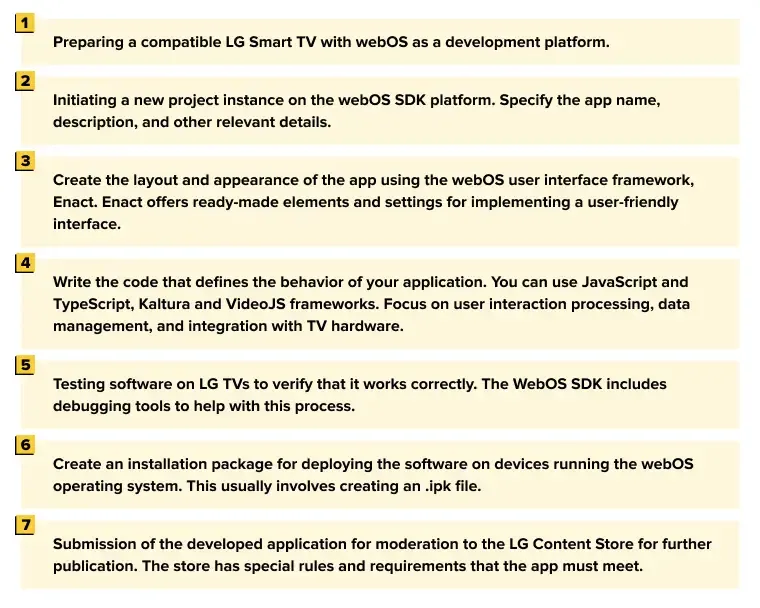
After successful moderation, the app will be published in the LG Content Store catalog and will be available to users. At the request of customers, we update the app over time.
Challenges in WebOS App Creation
During LG webOS TV app development, there are some challenges in regard to TV screen sizes, UX, and compatibility.
Screen Sizes
TV app developers have to take into account the different sizes of TV screens, remote control navigation, various middleware, and the overall performance of the solution on lower-powered devices.
Unlike mobile phones, where the touchscreen plays the main role, Smart TV apps depend on remotes, which can have a significant impact on the interface design and usability.
User Interface
UX requires caution: do not overload the interface with unnecessary elements to avoid making it too complicated. Quickly launching the view after a few simple actions is the best option.
To achieve this experience, it is necessary to implement smart content suggestions and a easy-to-understand hierarchy of screens.
The platform's responsive design feature allows applications to automatically adjust to different screen sizes and resolutions, ensuring that they look great on any device.
In addition, the platform supports animations, dynamic menus, and multilingualism, which improves the overall user experience and makes navigation and use of applications even more convenient.
Compatibility
The variety of Smart TV models and the constant evolution of operating systems make it difficult to develop universal applications. New operating systems are often not suitable for older devices, which limits the capabilities of apps.
To solve this difficulty, it is important to conduct a detailed compatibility analysis, determine the range of supported operating systems and develop a mechanism to ensure backward compatibility for outdated TV models.
The software should be optimized to run smoothly on the TV's hardware.
Thanks to the massive support of the webOS community, Lampa is able to develop system applications faster, more efficiently, and with greater user-friendliness, overcoming possible challenges along the way.
WebOS App Testing and Debugging
The Smart TV testing process is complex and time-consuming due to the variety of TV devices. App development on webOS has the advantage of access to the developer mode, which greatly facilitates the installation, debugging, and testing of applications.
To conduct effective tests, it is necessary to develop a detailed plan that includes a list of test devices and the rationale for their use. This is indispensable for testing features such as video streams or specialized navigation. For other scenarios, you can use emulators. For example, they allow you to take screenshots straight from the main OS.
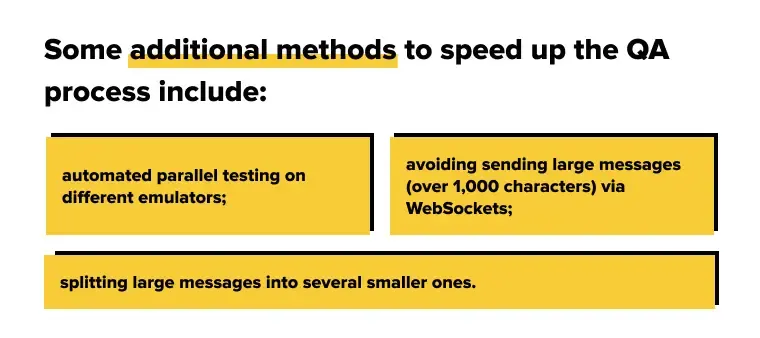
During the testing process on TV devices, the connection may be lost due to high loads. Therefore, it is recommended to use real devices only for those functions that cannot be tested on emulators and restart the debugging process regularly.
Testing smart TV apps is a complex job that combines manual and automated testing. Although automation is more expensive due to the technology involved, it pays off in the long run: it saves project time and allows you to detect even hidden bugs faster and more efficiently.
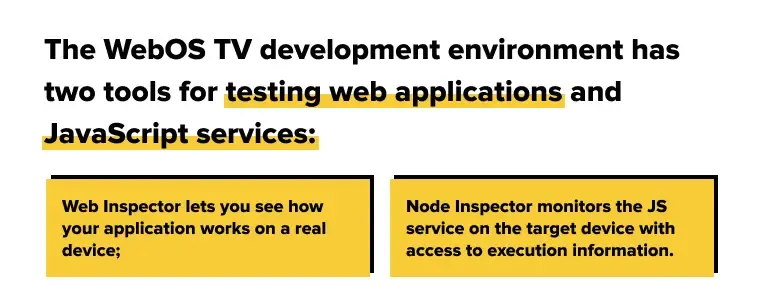
Their standard browser is Chromium, and since the IDE already includes this browser, there is no need to install it separately.
Prioritizing Performance and Security
Smart TV apps need to run stably, even on devices with limited processing power. You need to measure load times, response times, and streaming quality under different network conditions.
With Apache JMeter, you can simply simulate the actions of a number of users at the same time to test system performance and load balancing. GAT, WebLOAD, or Locust will help you understand how an application performs under extreme conditions, ensuring that it is efficient even during periods of peak activity.
In order to achieve the maximum level of personal data security, the application is comprehensively tested to detect potential vulnerabilities that can be used by attackers for unauthorized access. This includes testing the secure transmission of information, correct session processing, and protection against common threats.
A smart TV with webOS guarantees a wide range of security features that protect applications for end users. The platform supports secure communication, data encryption, and authentication. In addition, it includes a security review process for apps before they are published, which helps protect personal data.
Submitting Your WebOS App: A Step-by-Step Guide
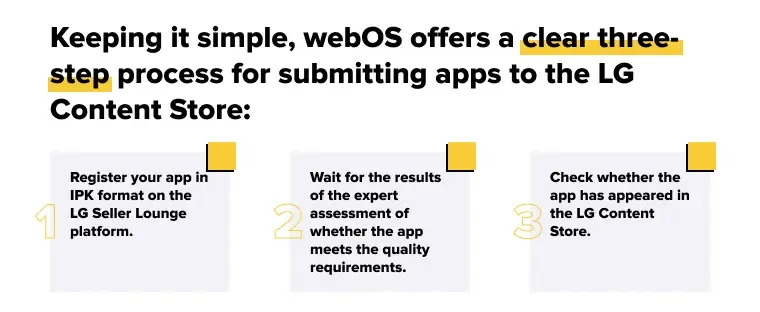
TV app developers have the opportunity to track the status of app submissions and receive feedback from LG, which contributes to the successful publication of the app.
This procedure is designed to ensure that all apps meet the performance and functionality standards of the platform.
WebOS App Monetization
The LG Smart TV operating system offers a variety of ways to monetize apps, including in-game purchases, subscriptions, and advertising.
The platform has a built-in payment system that makes it easy for content owners to manage app revenue.
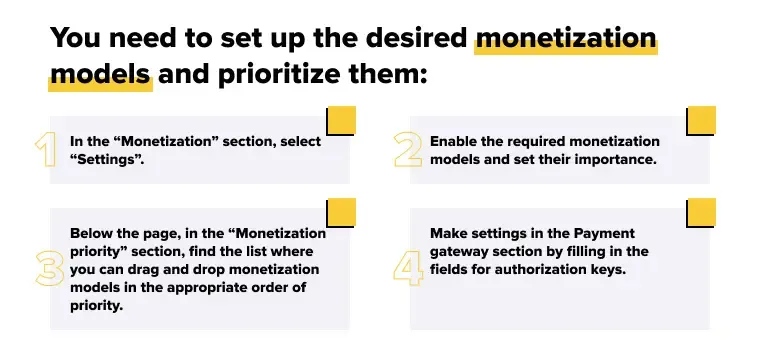
This way, you can earn income from the apps developed for you.
WebOS App Promotion
OTT advertising is distributed to different devices, such as smartphones and PCs. To be effective, you need to assess your audience to offer the right product.
To ensure that your ad on Smart TV doesn't get lost in the information flow, remember: the golden time for a video is 15 – 30 seconds. This is how much attention viewers are willing to pay to your brand.
Hulu, Disney+, and Netflix are not just platforms for watching movies. They are goldmines for advertisers! With exclusive content, you can reach millions of viewers who are eagerly awaiting new episodes of their most-viewed shows.
Advertising on popular streaming platforms guarantees increased brand awareness and sales.
Advertising on smart TVs can be as personalized as possible. LG incorporates streaming capabilities into its TVs, allowing viewers to access content without additional devices. Advertisers can target viewers with these smart TVs to maximize reach and impact.
With Lampa's services, your digital product can be available in the store within 24 hours of release.
Final Thoughts
As the Smart TV market continues to increase, LG webOS TV is a great platform for maximizing OTT opportunities. Despite the dominance of large companies, you have a chance to get involved and make your mark. By contacting the Lampa team, you will receive a modern solution with many useful features that will be appreciated by your target users.